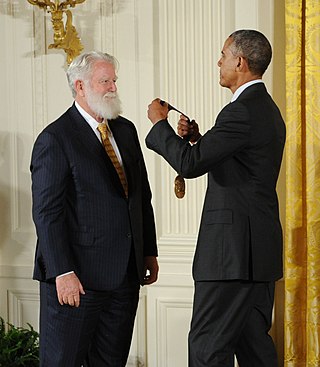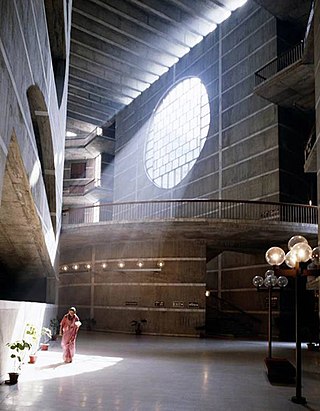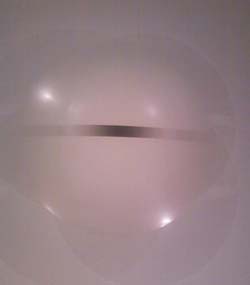Related Research Articles
Anya Gallaccio is a British artist, who creates site-specific, minimalist installations and often works with organic matter.

Dan Flavin was an American minimalist artist famous for creating sculptural objects and installations from commercially available fluorescent light fixtures.

Robert Walter Irwin was an American installation artist who explored perception and the conditional in art, often through site-specific, architectural interventions that alter the physical, sensory and temporal experience of space.

James Turrell is an American artist known for his work within the Light and Space movement. Much of Turrell's career has been devoted to a still-unfinished work, Roden Crater, a natural cinder cone crater located outside Flagstaff, Arizona, that he is turning into a massive naked-eye observatory; and for his series of skyspaces, enclosed spaces that frame the sky.

Architectural lighting design is a field of work or study that is concerned with the design of lighting systems within the built environment, both interior and exterior. It can include manipulation and design of both daylight and electric light or both, to serve human needs.

The Museum of Contemporary Art San Diego, in San Diego, California, US, is an art museum focused on the collection, preservation, exhibition, and interpretation of works of art from 1950 to the present.

Olafur Eliasson is an Icelandic–Danish artist known for sculptured and large-scaled installation art employing elemental materials such as light, water, and air temperature to enhance the viewer's experience.

A light fixture, light fitting, lamp, or luminaire is an electrical device containing an electrical component called a lamp that provides illumination. All light fixtures have a fixture body and one or more lamps. The lamps may be in sockets for easy replacement—or, in the case of some LED fixtures, hard-wired in place.
Tara Donovan is an American sculptor who lives and works in Brooklyn, New York. Her large-scale installations, sculptures, drawings, and prints utilize everyday objects to explore the transformative effects of accumulation and aggregation. Known for her commitment to process, she has earned acclaim for her ability to exploit the inherent physical characteristics of an object in order to transform it into works that generate unique perceptual phenomena and atmospheric effects. Her work has been conceptually linked to an art historical lineage that includes Postminimalism and Process artists such as Eva Hesse, Jackie Winsor, Richard Serra, and Robert Morris, along with Light and Space artists such as Mary Corse, Helen Pashgian, Robert Irwin, and James Turrell.

John Harvey McCracken was a minimalist artist. He lived and worked in Los Angeles, Santa Fe, New Mexico, and New York.
Larry Bell is an American contemporary artist and sculptor. He is best known for his glass boxes and large-scaled illusionistic sculptures. He is a grant recipient from, among others, the National Endowment for the Arts and the Guggenheim Foundation, and his artworks are found in the collections of many major cultural institutions. He lives and works in Taos, New Mexico, and maintains a studio in Venice, California.
Rudolf Stingel is an artist based in New York City.

Roman de Salvo(born 1965) is a contemporary American conceptual artist who creates sculpture and installation art.
Adriana Varejão is a Brazilian artist. She works in various disciplines including painting, drawing, sculpture, installation and photography. She was an artist-in-resident at the Isabella Stewart Gardner Museum in 2004. Varejão lives and works in Rio de Janeiro.

Light and Space denotes a loosely affiliated art movement related to op art, minimalism and geometric abstraction originating in Southern California in the 1960s and influenced by John McLaughlin. It is characterized by a focus on perceptual phenomena, such as light, volume and scale, and the use of materials such as glass, neon, fluorescent lights, resin and cast acrylic, often forming installations conditioned by the work's surroundings. Whether by directing the flow of natural light, embedding artificial light within objects or architecture, or by playing with light through the use of transparent, translucent or reflective materials, Light and Space artists make the spectator's experience of light and other sensory phenomena under specific conditions the focus of their work. From the movement's inception, artists were incorporating into their work the latest technologies of the Southern California-based engineering and aerospace industries to develop sensuous, light-filled objects. Turrell, who has spread the movement worldwide, summed up its philosophy in saying, "We eat light, drink it in through our skins."

The Kunsthaus Bregenz (KUB) presents temporary exhibitions of international contemporary art in Bregenz, Vorarlberg (Austria).

Robert Irwin is associated with the Modern Art movement and is best known for his Installation art. Philosophers influence Irwin’s work, such as Maurice Merleau-Ponty’s ideas of engagement and interaction between the physical world and people. Irwin reflects these ideas through his disc installations. From 1967-1969 he worked on this installation, which consists of convex discs made of metal and plastic. The discs hang on a wall and are illuminated by floodlights to create the illusion of no edges. It is a play on light, dark, shadows, and the space in which the discs lie in.
Paul Joseph Kos is an American conceptual artist and educator, he is one of the founders of the Bay Area Conceptual Art movement in California. Kos incorporates video, sound and interactivity into his sculptural installations. Currently Kos lives and works in San Francisco.
Eric Orr (1939–1998) is an American artist who lived and worked in Venice, California from 1965 to 1998. Before moving to Los Angeles in 1965, Orr was a civil rights worker in Mississippi. A key figure of the Light and Space movement, Orr developed alongside Southern California conceptual art and created perceptual-based installations commonly associated with Light and Space art. Orr's work spanned a variety of artistic practices (including installation art, sculpture, painting, and performance art that challenged the definition of art making. Orr's work incorporated a broad range of cultural references, including space icons found in ancient religions and cultures, Egyptian symbolism, and Buddhist spiritualism.

Dia Bridgehampton, previously known as the Dan Flavin Art Institute, is a museum in Bridgehampton, New York, opened in 1983 and run by the Dia Art Foundation. The museum houses nine fluorescent light works by Dan Flavin on permanent display, a gallery for temporary exhibitions, and a display on the history of the building. It is one of the locations and sites the Dia Art Foundation manages.
References
- ↑ Davies, Hugh M; Onorato, Ronald J; Blurring the Boundaries: Installation Art 1969-1996, Museum of Contemporary Art, San Diego (1997). ISBN 0-934418-44-6. p. 14.
- 1 2 Davies, pp. 74-75.
- ↑ Benjamin, Andrew; Installation Art, John Wiley & Sons (1995). ISBN 1-85490-213-X. p. 47.
- 1 2 Adcock, Craig; James Turrell: The Art of Light, University of California Press (December 20, 1990). ISBN 0-520-06728-2. p. 147
- ↑ Adcock, p. 148.
- ↑ "Southern Exposure", Museum of Contemporary Art, Sydney (2008). Retrieved 15 October 2010.